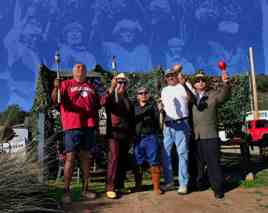
James Luna, Apparitions, 2008
Enacting Emancipation
James Luna, Emily Jacir, Erica Lord, John Halaka
A Space Main Gallery
June 28 – August 2, 2008
Opening June 28, 2008, 4:00 pm–7:00 pm
Curated by: Vicky Moufawad-Paul, Tannis Nielsen
When engaging with the similarity of colonial oppression between the Indigenous peoples of North America and Palestine, the late Edward Said stated that the task at hand was ‘to universalize the crisis, to give greater human scope to what a particular race or nation suffered, to associate that experience with the suffering of others.’ Enacting Emancipation was born from this intention.
This study of the interconnectedness of the First Nations and Palestinian experience was inspired by the sixtieth-year memorial of the Palestinian Nakba (catastrophe of 1948). The exhibition unravels a universal and international system of colonial technique and strategy, while remaining fully cognizant of the dangers in homogenizing resistant cultures. The curators sought contrast in defining strategies of resistance, which elucidated the fact that the differences of defense were culturally based and inheritably Indigenous.
Together the artists in this exhibition – James Luna, Emily Jacir, Erica Lord, and John Halaka – signify the individualized experiences of Fourth World peoples who have been stripped of context, denied distinction, and disenfranchised from traditional territories. Together they present an immediacy of need in defending land and citizenry, the recognition of sovereignty, and their personal engagements in the quest for freedom.

Biographies
James Luna is internationally recognized for his installation and performance art. A Puyokawichum (Luiseno) Indian and a resident of California’s La Jolla Indian Reservation, Luna creates his work for ‘a community of Indian tribes.’ He has received wide acclaim for his deconstruction of the stereotypes surrounding notions of Indian identity. His work confronts and challenges commonly held views of American Indians, museums, art, and life. He does this with irony, humour, sorrow, and a strong sense of storytelling in motion. Luna’s performances have been presented at the Whitney Museum of American Art in New York City, the National Gallery of Canada, San Francisco’s Mexican Museum, and the Institute of American Indian Arts in Santa Fe. He represented the National Museum of the American Indian at the 2005 Venice Biennale.
Emily Jacir is a Palestinian artist whose projects span a diverse range of strategies and media including film, photography, installation, performance, video, writing, and sound. She received a BA from the University of Dallas in 1992 and an MFA from the Memphis College of Art in 1994. Jacir has shown extensively throughout Europe, the Americas, and the Middle East since 1994. Her 2007 solo exhibitions include Kunstmuseum, St.Gallen, Switzerland; Villa Merkel, Esslingen, Germany; and Alberto Peola Arte Contemporanea, Torino, Italy. Jacir’s ongoing project about Wael Zuaiter, entitled Material for a film, was featured at the 52nd Venice Biennale, where she awarded the Golden Lion. She splits her time between Ramallah and New York City.
Erica Lord (Athabaskan/I–upiaq) was born in Alaska, but abiding her cultural tradition of nomadic life, she has spent her years bouncing both physically and metaphorically between her home village in Alaska and the Finnish-American nucleus of Upper Michigan. She has exhibited in the Smithsonian’s National Museum of the American Indian, the CN Gorman Museum, and the Schopf Gallery on Lake in Chicago. Lord received a BA from Carleton College and an MFA from the School of the Art Institute of Chicago. She has taught in the visual arts department at the Evergreen State College in Olympia, Washington, and is currently the artist-in-residence at the School for Advanced Research in Santa Fe, New Mexico.
John Halaka is of Palestinian descent and was born in El Mansoura, Egypt, in 1957. He is a professor of painting and drawing at the University of San Diego, where he has taught since 1991. He received a BA in Fine Arts from the City University of New York Baccalaureate Program in 1979 and an MFA in Visual Arts from the University of Houston in 1983. Halaka has exhibited his work in solo and group exhibitions both locally and nationally. His work was included in the exhibit Made in Palestine, organized by the Station Museum in Houston Texas, as well as in IN-VISIBLE, the inaugural exhibition at the Arab American National Museum in Detroit, Michigan.
Vicky Moufawad-Paul is a Toronto based curator and writer. She is the Director/Curator at A Space Gallery. She has curated exhibitions at the Agnes Etherington Art Centre, Carlton University Art Gallery, Gallery 101, MAI: Montreal arts interculturels, Latitude 53, Museum London, McIntosh Gallery, Contact Photography Festival, InterAccess Electronic Media Arts Centre, Prefix Institute of Contemporary Art, A Space Gallery, and 16 Beaver. She has an undergraduate degree from the University of Western Ontario and an MFA in Film and Video from York University. Moufawad-Paul has published texts on several artists including Harun Farocki, James Luna, Emily Jacir, Wafaa Bilal, Paul Dennis Miller, Deirdre Logue, Mohammed Mohsen, Jacqueline Hoang Nguyen, Juan Ortiz-Apuy, Basil AlZeri, Erica Lord, John Halak, Rehab Nazzal, Adam Broomberg, Oliver Chanarin, Akram Zaatari, and Yto Barrada.